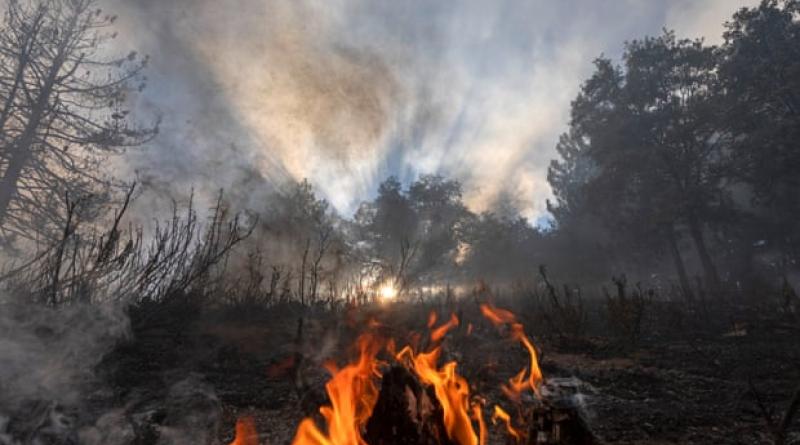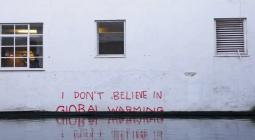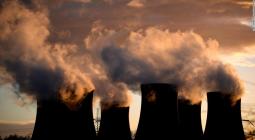In tackling the global climate crisis, doom and optimism are both dangerous traps.

Overheated polemics won’t solve this emergency – and the apocalypse is a needlessly high bar for action.
Protesters march in the streets in an “extinction rebellion” against the climate crisis, with some (but not all) of their leaders claiming that climate tipping points could kill billions in the coming decades. Others dismiss the importance or reality of the crisis, while new books loudly proclaim “apocalypse never” and “false alarm”.
The popular discourse around the climate emergency all too often highlights fringe voices that predict the end of the world or suggest that there is little to worry about. But as the climatologist Steven Schneider presciently remarked a decade ago, when it comes to the climate “the end of the world” and “good for us” are probably the two least likely outcomes.
The environmental crisis is one of the most serious and pressing issues facing the world today. We are already living with impacts of human-caused global heating, and the world is not doing nearly enough yet to put us on a pathway to avoiding potentially dire impacts later in the century to both humans and the natural world. But a discourse sharply divided between doom and dismissal risks obstructing climate action, rather than motivating it.
Climate impacts are often framed as an issue of thresholds: we must limit warming to below certain specific numbers, beyond which there be dragons. However, the science suggests that the climate crisis is really an issue of degree. There is no magic line that we know of beyond which things suddenly transition from manageable to catastrophic. Rather, the damage becomes worse the more warming that occurs – often exponentially so.
When we try to project how the climate might change in the future, we confront three big uncertainties: how much greenhouse gases humans will emit, how the accumulation of CO2 in the Earth’s atmosphere might change as a result, and how sensitive atmospheric temperatures are to this.
On the first of these we have some reason for modest optimism. The world has made progress on slowing the rise in emissions over the past decade. Global carbon dioxide emissions have still been rising, but only at half the rate they were in the 2000s. Use of coal – the most CO2-intensive fossil fuel – peaked in 2013 and has been declining since. We have succeeded in making clean energy cheaper, and low-carbon sources now provide more energy than coal worldwide. Nightmare scenarios where global emissions triple by the end of the century now seem far less likely as we see them near a plateau.
At the same time, there is an ever-growing gap between where we are today and the emissions reductions needed to limit warming to globally agreed-upon targets. CO2 accumulates in the atmosphere over time, so reducing emissions does not stop the world from warming. To stop global temperatures from rising, our emissions need to go all the way down to zero.
The news on climate sensitivity is more mixed. Scientists have long struggled to pin down exactly how much the Earth will warm if the amount of CO2 in the atmosphere were to double, and have had some recent success on that front. The bad news is that we can effectively rule out low levels of warming, so we can no longer trust to luck and hope that we can still let CO2 build up and warming will be small. The slightly better news is that very high levels of warming also seem less likely than previously thought – but this is a less certain result.
Feedbacks may also be important. Today, about half of our CO2 emissions are absorbed by the oceans and land vegetation, but this could weaken as the oceans become warmer, and as drier soils, more frequent fires and thawing permafrost result in more CO2 being released. Many of these processes are included in our climate models, but it is still unclear how fast these changes will occur and what the overall effect on the build-up of CO2 in the atmosphere will be.
Current policies adopted by countries put us on track for very roughly around 3C (5.4F), of planetary heating by the end of the century, compared to the time before the industrial revolution. But heating could well be substantially higher – or lower – than this best estimate. Also, these global average numbers are not the full picture: land regions, where we all live, will heat around a third faster than the planet as a whole, and the polar regions faster still.
Uncertainty is not our friend. Because expected damages increase faster the hotter it gets, we stand a real risk of catastrophic impacts if we end up with an unlucky combination of a highly sensitive climate and faster accumulation of CO2. We will also have fewer options to stop or reverse this by the time it happens. These uncertainties are why it’s all the more important to control the one thing we can: our future emissions.
Humans are remarkably adaptable, using technology to live comfortably in some of our planet’s most extreme environments. It is very unlikely that global heating – at least by itself – could pose an existential risk to our species. At the same time, our ability to adapt rapidly to changes in our environment depends in part on access to technology and the resources to adopt it. The climate crisis is better thought of as an existential risk multiplier: in a world characterised by extreme poverty and inequality, conflict and weak institutions it could help push some societies over the brink. The severity of climate impacts depends not just on our emissions but on how well we tackle political challenges.
We also need to acknowledge that the natural world largely lacks our adaptive capacity. The climate crisis is already wreaking havoc on fragile ecosystems such as coral reefs. Unmitigated, it could drive many of the world’s species to extinction as they are unable to survive changing temperatures. Deforestation, pollution and other environmentally damaging activities make the natural world more vulnerable to disruptions from climate change. Addressing them can help make nature more resilient.
This crisis will not be solved quickly or easily, and overheated polemics are not helping. While it won’t be good for us, it also won’t be the literal end of the world. But the apocalypse is a needlessly high bar to take action. Though most of the challenges we overcome as a species are not existential risks, they are nonetheless critically important. We see a real risk that dwelling on doom may serve to obstruct climate action rather than motivating it, promoting fatalism and further polarisation. There is also evidence that fear is not a very effective tool to engage people around the climate. But dismissing the severity of climate impacts and the real possibility of worst-case outcomes is also an extremely dangerous gamble. The risks are serious enough, and we need a common understanding of the urgent need to tackle them.
• Zeke Hausfather is director of climate and energy at the Breakthrough Institute in Oakland, California. Richard Betts is head of climate impacts research at the Met Office Hadley Centre and University of Exeter
6 August 2020
The Guardian





